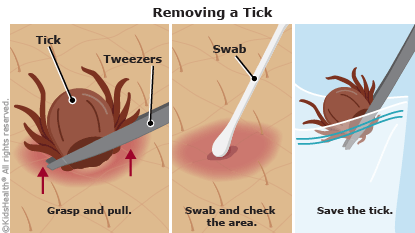Evaluate Your Child's Lyme Disease Risk
Article Translations: (Spanish)
In warm weather, the threat of Lyme disease might make you think that your kids would be safer in your living room than in the great outdoors.
Although the risk of getting Lyme disease from a tick bite is only about 1%–2%, it's important to know what can affect your family's Lyme disease risk.
What Areas Are Most Affected?
Lyme disease is the leading tick-borne disease in the United States, with 20,000 to 30,000 cases reported to the Centers for Disease Control and Prevention (CDC) each year. Most U.S. cases of Lyme disease happen in the Northeast, upper Midwest, and Pacific coast areas.
Lyme disease has been reported in other states (and even in Asia, Europe, and Canada), but those hardest hit are:
- Connecticut
- Delaware
- Maine
- Massachusetts
- Maryland
- Minnesota
- New Hampshire
- New Jersey
- New York
- Pennsylvania
- Rhode Island
- Wisconsin
- Vermont
- Virginia
Most Lyme disease cases happen between April and October, particularly in June and July.
Outdoor Activities and Pets
Besides living in one of these areas, other things that might increase someone's risk include:
- spending a lot of time outdoors in tall grass, brush, shrubs, or wooded areas
- having pets that may carry ticks indoors
- activities such as landscaping, hiking, camping, fishing, or hunting in tick-infested areas
Can Lyme Disease Be Prevented?
Taking some precautions can help protect your family from Lyme disease — such as using insect repellent and wearing light-colored clothing when outdoors to make it easier to see a tick. And you should know how to remove a tick, just in case.
If you find a tick:
- Call your doctor, who may want you to save the tick after removal for identification as the type that may carry Lyme disease or another type of illness. Put the tick in a sealed container to preserve it.
- Use tweezers to grasp the tick firmly at its head or mouth, next to the skin.
- Pull firmly and steadily on the tick until it lets go of the skin. If part of the tick stays in the skin, don't worry, it will eventually come out — although you should call your doctor if you notice any irritation in the area or symptoms of Lyme disease.
- Swab the bite site with alcohol.
Note: Don't use petroleum jelly or a lit match to kill a tick — they won't get the tick off of skin and might make the insect burrow deeper and release more saliva (which increases the chances of disease transmission).
It's important to remove a tick as soon as possible. Usually, bacteria from a tick bite will enter the bloodstream only if the tick stays attached to the skin for 24–48 hours or longer.
Note: All information is for educational purposes only. For specific medical advice, diagnoses, and treatment, consult your doctor.
© 1995-2024 KidsHealth ® All rights reserved. Images provided by iStock, Getty Images, Corbis, Veer, Science Photo Library, Science Source Images, Shutterstock, and Clipart.com


